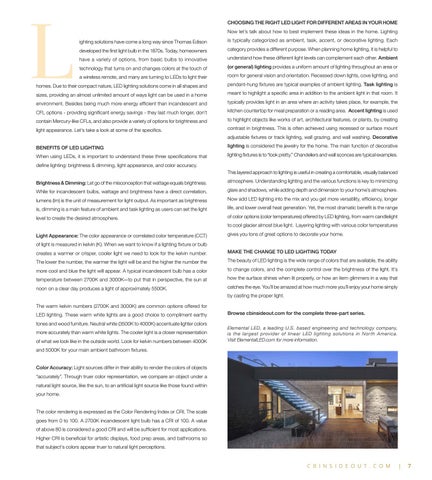L
CHOOSING THE RIGHT LED LIGHT FOR DIFFERENT AREAS IN YOUR HOME Now let’s talk about how to best implement these ideas in the home. Lighting ighting solutions have come a long way since Thomas Edison
is typically categorized as ambient, task, accent, or decorative lighting. Each
developed the first light bulb in the 1870s. Today, homeowners
category provides a different purpose. When planning home lighting, it is helpful to
have a variety of options, from basic bulbs to innovative
understand how these different light levels can complement each other. Ambient
technology that turns on and changes colors at the touch of
(or general) lighting provides a uniform amount of lighting throughout an area or
a wireless remote, and many are turning to LEDs to light their
room for general vision and orientation. Recessed down lights, cove lighting, and
homes. Due to their compact nature, LED lighting solutions come in all shapes and
pendant-hung fixtures are typical examples of ambient lighting. Task lighting is
sizes, providing an almost unlimited amount of ways light can be used in a home
meant to highlight a specific area in addition to the ambient light in that room. It
environment. Besides being much more energy efficient than incandescent and
typically provides light in an area where an activity takes place, for example, the
CFL options - providing significant energy savings - they last much longer, don’t
kitchen countertop for meal preparation or a reading area. Accent lighting is used
contain Mercury-like CFLs, and also provide a variety of options for brightness and
to highlight objects like works of art, architectural features, or plants, by creating
light appearance. Let’s take a look at some of the specifics.
contrast in brightness. This is often achieved using recessed or surface mount adjustable fixtures or track lighting, wall grazing, and wall washing. Decorative
BENEFITS OF LED LIGHTING
lighting is considered the jewelry for the home. The main function of decorative
When using LEDs, it is important to understand these three specifications that
lighting fixtures is to “look pretty.” Chandeliers and wall sconces are typical examples.
define lighting: brightness & dimming, light appearance, and color accuracy. This layered approach to lighting is useful in creating a comfortable, visually balanced Brightness & Dimming: Let go of the misconception that wattage equals brightness.
atmosphere. Understanding lighting and the various functions is key to minimizing
While for incandescent bulbs, wattage and brightness have a direct correlation,
glare and shadows, while adding depth and dimension to your home’s atmosphere.
lumens (lm) is the unit of measurement for light output. As important as brightness
Now add LED lighting into the mix and you get more versatility, efficiency, longer
is, dimming is a main feature of ambient and task lighting as users can set the light
life, and lower overall heat generation. Yet, the most dramatic benefit is the range
level to create the desired atmosphere.
of color options (color temperatures) offered by LED lighting, from warm candlelight to cool glacier almost blue light. Layering lighting with various color temperatures
Light Appearance: The color appearance or correlated color temperature (CCT)
gives you tons of great options to decorate your home.
of light is measured in kelvin (K). When we want to know if a lighting fixture or bulb creates a warmer or crisper, cooler light we need to look for the kelvin number.
MAKE THE CHANGE TO LED LIGHTING TODAY
The lower the number, the warmer the light will be and the higher the number the
The beauty of LED lighting is the wide range of colors that are available, the ability
more cool and blue the light will appear. A typical incandescent bulb has a color
to change colors, and the complete control over the brightness of the light. It’s
temperature between 2700K and 3000K—to put that in perspective, the sun at
how the surface shines when lit properly, or how an item glimmers in a way that
noon on a clear day produces a light of approximately 5500K.
catches the eye. You’ll be amazed at how much more you’ll enjoy your home simply by casting the proper light.
The warm kelvin numbers (2700K and 3000K) are common options offered for LED lighting. These warm white lights are a good choice to compliment earthy tones and wood furniture. Neutral white (3500K to 4000K) accentuate lighter colors more accurately than warm white lights. The cooler light is a closer representation of what we look like in the outside world. Look for kelvin numbers between 4000K
Browse cbinsideout.com for the complete three-part series. Elemental LED, a leading U.S. based engineering and technology company, is the largest provider of linear LED lighting solutions in Nor th America. Visit ElementalLED.com for more information.
and 5000K for your main ambient bathroom fixtures. Color Accuracy: Light sources differ in their ability to render the colors of objects “accurately”. Through truer color representation, we compare an object under a natural light source, like the sun, to an artificial light source like those found within your home. The color rendering is expressed as the Color Rendering Index or CRI. The scale goes from 0 to 100. A 2700K incandescent light bulb has a CRI of 100. A value of above 80 is considered a good CRI and will be sufficient for most applications. Higher CRI is beneficial for artistic displays, food prep areas, and bathrooms so that subject’s colors appear truer to natural light perceptions.
C B I N S I D E O U T . C O M
06_18_OC_Ed1_LED_Spread.indd 3
|
7
6/9/16 9:13 AM
